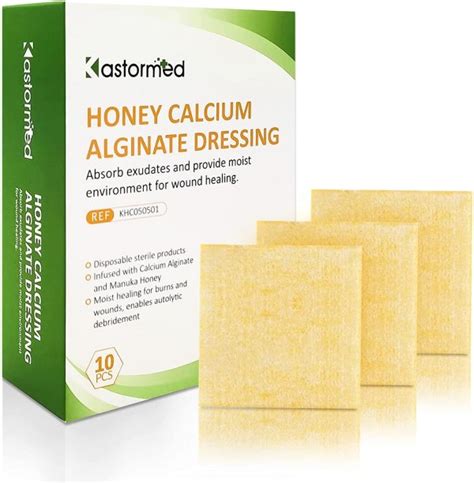Calcium alginate wound dressings have become a staple in modern wound care due to their unique properties and benefits. Derived from brown seaweed, these dressings are composed of alginate, a naturally occurring polymer that reacts with calcium ions to form a gel-like substance. This gelation process not only helps to maintain a moist environment, which is crucial for wound healing, but also provides a protective barrier against bacteria and other contaminants. As a result, calcium alginate dressings are widely used in the treatment of various types of wounds, including chronic wounds, burns, and surgical incisions.
Key Points
- Calcium alginate dressings promote a moist environment conducive to wound healing
- They provide a protective barrier against bacterial and other contaminant infections
- These dressings are highly absorbent, making them suitable for wounds with high exudate levels
- Calcium alginate dressings can be used on a variety of wound types, including chronic wounds and burns
- They are generally well-tolerated and can be easily removed without causing damage to the wound or surrounding skin
Composition and Properties

The composition of calcium alginate dressings is primarily based on the alginate material, which is extracted from brown seaweed. When this alginate comes into contact with calcium ions, typically from the wound exudate or a calcium-rich solution, it undergoes a process called gelation. This transformation from a dry, fibrous state to a moist, gel-like state is what gives calcium alginate dressings their unique properties. The gel formed is not only highly absorbent but also provides a moist environment that fosters wound healing. Additionally, the presence of calcium ions can help to stimulate the healing process by promoting the migration of cells necessary for tissue repair.
Absorbency and Moisture Retention
One of the key advantages of calcium alginate dressings is their high absorbency. They are capable of absorbing several times their weight in fluid, making them particularly useful for wounds with high levels of exudate. The absorbed fluid is locked into the gel, preventing it from leaking out and reducing the need for frequent dressing changes. This moisture retention also helps to keep the wound environment consistently moist, which is essential for the healing process. A moist environment promotes autolytic debridement (the body’s natural process of removing dead tissue), enhances cell migration, and supports the overall healing process.
| Property | Calcium Alginate Dressings |
|---|---|
| Absorbency | High, up to 20 times their weight |
| Moisture Retention | Excellent, maintains a moist wound environment |
| Antimicrobial Properties | May vary, some products have added antimicrobial agents |
| Usage | Versatile, can be used on various wound types including chronic wounds, burns, and surgical incisions |

Clinical Applications and Benefits

Clinically, calcium alginate dressings are applied to a wide range of wounds due to their beneficial properties. They are particularly useful for wounds with high levels of exudate, as their absorbency helps to manage fluid and prevent maceration of the surrounding skin. Additionally, the moist environment they create is conducive to autolytic debridement, which is the body’s natural process of removing dead tissue, thereby promoting a clean wound bed that is more receptive to healing. The protective barrier they form also reduces the risk of infection, a critical consideration in wound care.
Practical Considerations and Limitations
While calcium alginate dressings offer numerous benefits, there are practical considerations and limitations to their use. For example, they may not be suitable for dry wounds or those with minimal exudate, as the alginate requires moisture to gel and function effectively. Furthermore, the frequency of dressing changes can vary depending on the amount of exudate and the specific product used. It is also important to note that while calcium alginate dressings can help manage bacterial contamination, they are not a substitute for proper wound cleaning and debridement when necessary.
In terms of patient comfort and tolerance, calcium alginate dressings are generally well-received. They can be easily removed without causing damage to the wound or surrounding skin, which is a significant advantage over some other dressing types. However, as with any wound dressing, it is essential to monitor the wound closely for signs of infection or other complications and to adjust the treatment plan as needed.
What types of wounds are calcium alginate dressings most suitable for?
+Calcium alginate dressings are most suitable for wounds with high levels of exudate, such as chronic wounds, burns, and surgical incisions. They are particularly beneficial for wounds that require a moist environment to heal.
How often should calcium alginate dressings be changed?
+The frequency of dressing changes depends on the amount of exudate and the specific product used. Generally, dressings should be changed when they become saturated with fluid or as directed by a healthcare professional.
Are calcium alginate dressings comfortable for patients?
+Yes, calcium alginate dressings are generally well-tolerated by patients. They are designed to be gentle on the skin and can be easily removed without causing damage to the wound or surrounding tissue.
In conclusion, calcium alginate wound dressings offer a valuable tool in the management of various wound types. Their unique properties, including high absorbency and the ability to maintain a moist environment, make them particularly beneficial for promoting wound healing. As with any wound care product, it is essential to use calcium alginate dressings as part of a comprehensive treatment plan that includes regular wound assessment, proper wound cleaning, and debridement when necessary. By doing so, healthcare professionals can optimize the healing process and improve patient outcomes.
